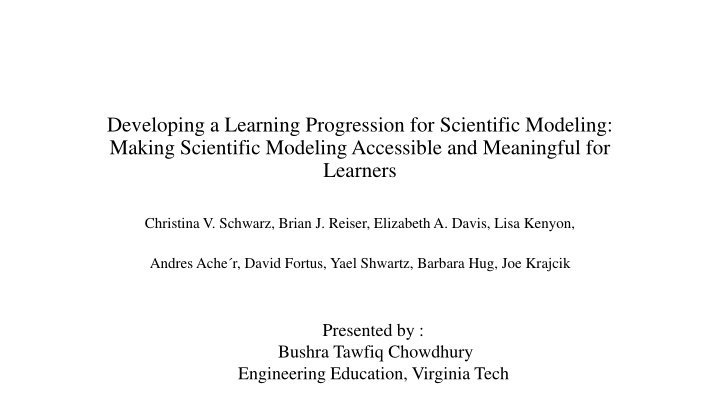



Developing a Learning Progression for Scientific Modeling: Making Scientific Modeling Accessible and Meaningful for Learners Christina V. Schwarz, Brian J. Reiser, Elizabeth A. Davis, Lisa Kenyon, Andres Ache´r, David Fortus, Yael Shwartz, Barbara Hug, Joe Krajcik Presented by : Bushra Tawfiq Chowdhury Engineering Education, Virginia Tech
Me : Bushra Undergrad: Computer Science, Dhaka University Graduate school: Security Informatics, Johns Hopkins Teaching: BRAC University Consulting: UNDP, Government of Bangladesh Now: PhD student, Engineering Education, Virginia Tech Future: Work with a group of people with same beliefs: technology should make things easier not harder
• What is the paper about ? • How is it relevant to Computational Thinking
This paper is about Scientific modeling Learning progression
Annotation paragraph The paper is good starting point for understanding modeling and its implications. The findings of the paper defines 4 levels of use of models as generative tools for explaining and predicting and another 4 levels which shows the differences between changes in models as understandings improve. …… will add a line or two after presentation
Scientific Modeling is…..
What is scientific modeling ? 1. Abstracts 2. Simplifies a system 3. Focuses on key features 4. Explain 5. Predict scientific phenomena
Learning progression HOW WHY WHEN
This paper investigates the following questions 1. What aspects of modeling practice can be made meaningful and productive for science learners? 2. What successes and challenges emerge when students engage in modeling practices?
The framework used Integration of • metamodeling knowledge and elements of the practice • sensemaking and communicative aspects of the practice
What is metamodeling knowledge ? 1. how models are used 2. why they are used 3. what their strengths and 4. limitations
For this study “the practice of modeling” means 1. Students construct models consistent with prior evidence and theories to illustrate, explain, or predict phenomena. 2. Students use models to illustrate, explain, and predict phenomena. 3. Students compare and evaluate the ability of different models to accurately represent and account for patterns in phenomena, and to predict new phenomena. 4. Students revise models to increase their explanatory and predictive power, taking into account additional evidence or aspects of a phenomenon.
Sensemaking and communicative aspects of the practice Sensemaking Communicative • for themselves • the learners are at the point where they are readyto share • to try to understand a their ideas with others, phenomenon • articulating their model to see if • articulating their understanding others agree as an expressed model to help • try to persuade others or help • clarify their thinking and them understand the phenomena. • develop group consensus
How ? • 5 th and 6 th grades students • Modeling evaporation and condensation phenomena, Can I believe my eyes? How can I smell things from a distance? • Focus group interviews by the researchers
What are the differences ?
Results • Models as Generative Tools for Explaining and Predicting • Models Change as Understandings Improve
Where do you see Computational Thinking ? Or Elements of Computational thinking ?
• The definition of scientific modeling • The learning progression • The way it has been assessed • Can computational thinking help students to model better ?
Thank you
Recommend
More recommend